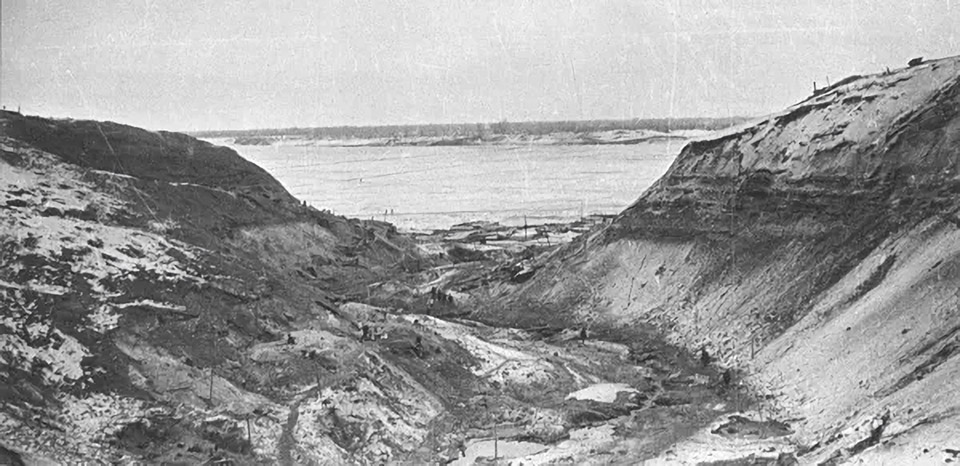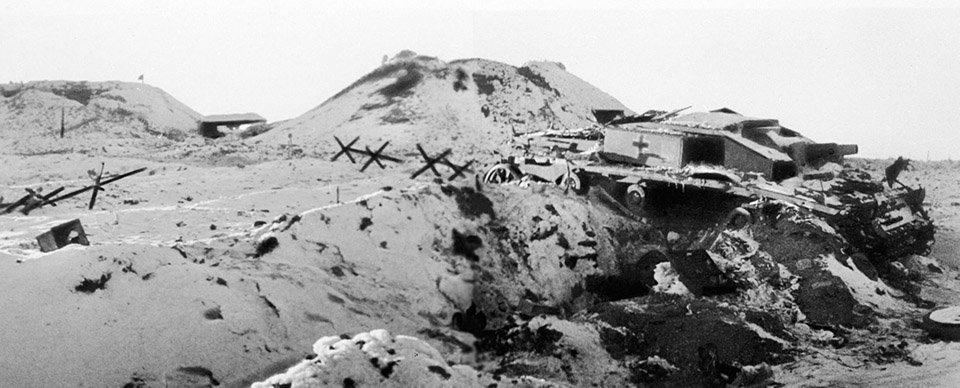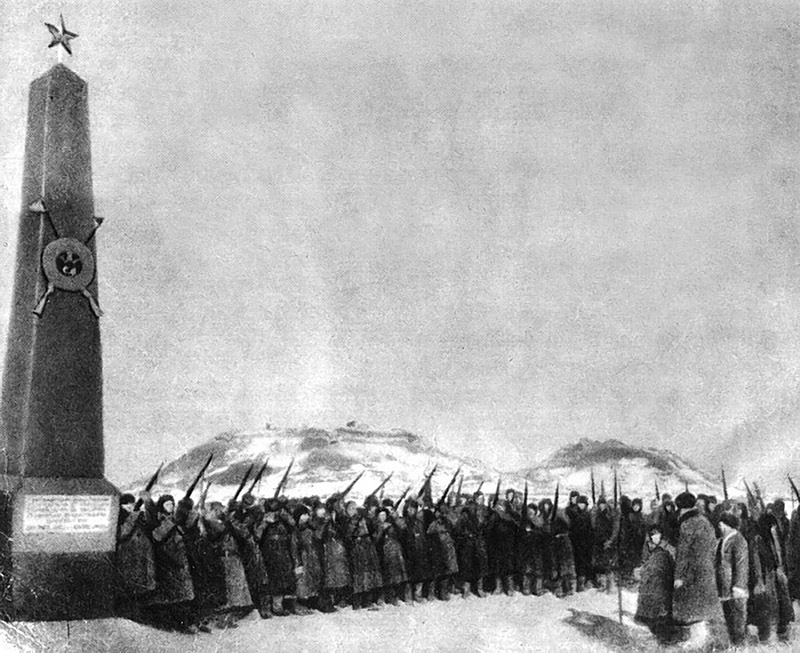Fights for Mamayev Kurgan were supported by front and army artillery, regimental RA and MS, Regimental, divisional and battalion Army and artillery ships. 37 platoons and units took part in fights on Mamayev Kurgan.
Fights for Mamayev Kurgan took place between September 1942 and January 1943, the fighting lasted for 135-140 days according to the various archival and published data.
Most of the time 133 days Mamayev Kurgan was defended by the 284th Infantry Division under Colonel N.F. Batjuk.
The line of the front edge of 284th Division consisted of the right flank — from Banny ravine (now Vozrozhdeniya Square or Renaissance Square) along Moscow branch of the railway, north-eastern slope of Mamayev Kurgan, and the left flank – across a hardware factory (now the territory of ZTDiN — a factory of tractors’ parts and normalis.
Mamayev Kurgan became a key position in the defense of Stalingrad. It was marked on military-topographic maps as Hill 102,0. There are higher hills in the city: such as Hill 107.5 (the Germans called it "Flowerpot") in Krasnooktyabrsky district at the 2nd Prodolnaya Line, and Hill 112.0 in Soviet district where the Academy of Agriculture is situated nowadays. Also there is a Hill 145.5 that is a well-known Lysaya (Bald) Mountain, where parts of the 64th Army fought. However, the location of Mamayev Kurgan, advanced to the Volga river, was so proper that it was easy to see the city’s outskirts and forests in the distance where hospitals, reserves, headquarters of the Soviet troops were located at the time of Stalingrad Battle. From the top of Mamayev Kurgan they could see the Volga River crossing vital for bringing all war supplies and reinforcements of 62d Army from the left bank. Northern industrial areas were spread before the eyes with their famous giant factories which produce military munitions, also the city center was viewed with a rail junction and a river port. That's why brutal bloody fights raged for this hill more than four months.
In early September, the command post of the 62nd Army was located here, but on 13 September the enemy took the offensive at the station and Mamayev Kurgan, and the command post was moved to a tunnel into the slope on the left bank of the Tsarina river, then it was moved to the territory of “Red October” factory, but most of the time it was located at the foot of Mamayev Kurgan into the steep slope of the Volga riverside. On the shore there is a memorial sign with an inscription: “Here on the bank of the Volga river during the Battle of Stalingrad from October, 18, 1942 till February, 2, 1943 the command post of a commander of the 62nd Army, Lieutenant General V.I. Chuikov was situated”.
In the middle of September the enemy began assaulting Mamayev Kurgan. German airplanes made circles continuously above the hill, dropping bombs. Mines and shells rained down, a sea of fire and acrid smoke raged around. Burned, pitted with deep mine craters, shell holes and entrenchments, covered like scales with splinters, Mamayev Kurgan showed black later in the winter like charred.
The enemy engaged to action German reserves attacking Soviet forces. Divisions of 112th Division under Ermolkin and one of regiments of 10th Division of NKVD (People's Commissariat for Internal Affairs) couldn't resist to them. In September German troops captured the hill with huge losses. Position of defending soldiers of Red Army was severe. In the morning on September, 16 one of Soviet regiments with some units of the 112th Division began to attack the Hill. They managed to recapture its top, but then the offensive came to a standstill. The encounter attacks started fighting which lasted until the end of January, 1943.
On September, 18 the battle for Hill 102.0 was entered by the 95th Division of the Colonel V. A. Gorishny. On 22 September Siberians from the 284th division of N. F. Batjuk began crossing from the left bank of the river. They took a mission to stop enemy’s approaching to the city. So till the end of the Battle the 284th Division staunchly defended Mamayev Kurgan.
From September 27 till October 4 there were bloody fightings for workers’ settlements on northern factories and Mamayev Kurgan. The 95th Division was pushed aside from the western and southern slopes of the hill. The next day Gorishny’s and Batjuk’s soldiers managed to capture an important point (to the south of water sedimentation tanks), but they couldn’t reach the tanks. The top, fired from both sides, remained a no man’s land. It is difficult to say how many times it changed hands. In the beginning of October Hitlerites consolidated their position on Hill 102.0, by the means of a considerable quantity of tanks, artillery and aircraft. They transformed water sedimentation tanks into strongly reinforced bunkers. But northern and eastern slopes were kept firmly by Soviet soldiers.
In the beginning of October the 284th Division occupied a part of Metallurgists’ settlement on the right and they kept east slopes with Metiz (hardware) factory on the left. The position of the 284th Division was very difficult. Their enemy camouflaged all their artillery and aimed fire at all ways to the Volga from the east.
Single boats, cars with ammunition were fired by Germans. It was possible to deliver food, equipment and to take out wounded Russian soldiers only at nights. But even in the dark German flash cartridges lit up the front edge and the depth of defense line, and the enemy fired all weapons.
From the middle of October the Division had a hard time. The enemy tried to make his way through to the Volga river attacking the factory’s territoty.
The Batjuk’s Division merged with Mamayev Kurgan, with its spurs, making decision to fight to the death. The Nazis built numerous fortifications on the top, organized a strong system of fire and minefields. They tried to attack Russian troops 10-12 times a day but, losing people, weapons and equipment, they failed to capture all the entire territory of the Kurgan.
Continuous fightings went round water sedimentation tanks. Till January, 12, 1943 it was not possible for Batjuk’s Siberians to make a stand on the top of Mamayev Kurgan . In January it was decided to capture this important tactical key position in the city at any cost. Soviet soldiers thoroughly got ready to the future assault . The storm began with massed artillery and mortar fire. Soviet artilleries were given a task to break the concrete tanks shells. Guns and mortars shot from across the Volga. Everything was shaken because of explosions of shells of Katyusha multiple rocket launchers and aerial bombs. At 2 am Russian infantry rushed to attack. By the morning the hill was taken by Soviet Army. Fascists lost a possibility to watch the regrouping of Soviet troops in the city.
The Offensive of Batjuk’s Division over Mamayev Kurgan was constantly met with the enemy counterattacks all the time till January 25. It was the only place in the city where the enemy still tried to counterattack.
On January, 26, 1943, breaking the last resistance of the enemy, Siberian Batjuk’s Division came to the west and met the soldiers of the 21st Army.
Later a pedestal tank T-34 was put up on the place of this meeting for the first soldiers who made their way towards to soldiers of the 62nd Army. This tank was constructed by Ural machine engineers on means of collective farmers of Chelyabinsk region, who presented lots of such machines to the front. That is why this tank is called “Chelyabinsk collective farmer”. There is a memorial plaque on the pedestal with an inscription: “Here, on January, 26, 1943 at 10:00 a.m there was a meeting of a tank, travelling from the west ahead of a colonel Nezhinsky‘s tank brigade, with units of the 62nd Army. Formation of the 121st Tank Brigade with units of the 62nd Army divided the enemy group into 2 parts, and helped to annihilate them”.
On January, 26, 1943 Mamayev Kurgan and its environs were completely cleared of the enemy soldiers. On February 8 in 6 days after the end of the Battle, Soviet defenders of Hill 102.0 were buried here, in their honor salute thundered from the fighting weapons of Stalingrad soldiers, and a simple monument was put up over the grave. It was a wooden obelisk with two crossed rifles.


